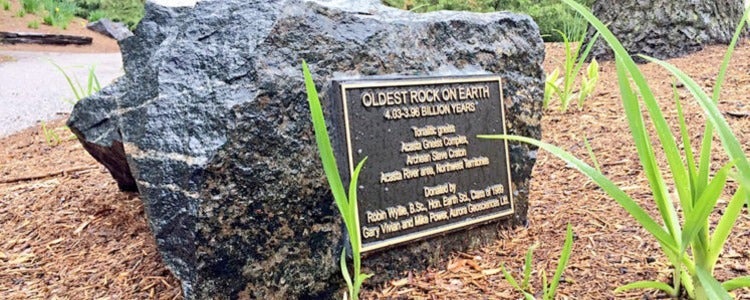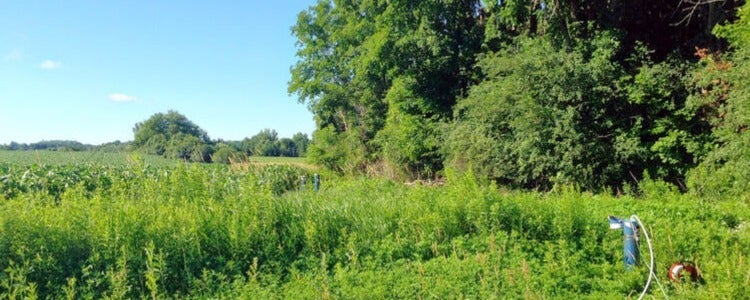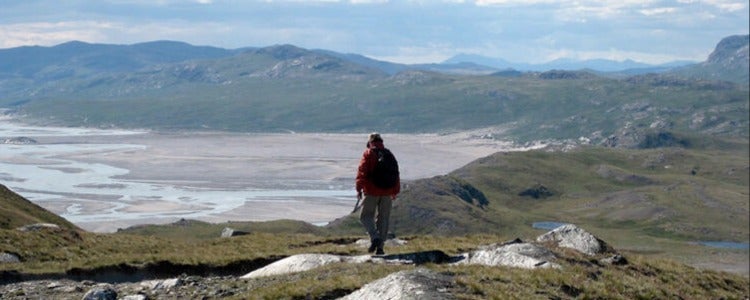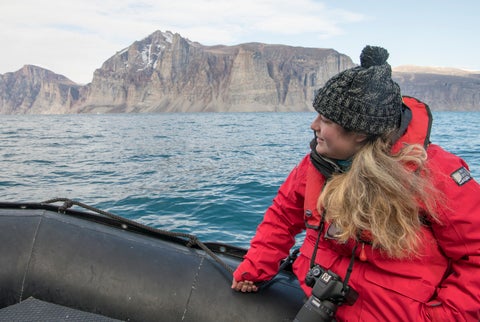Written by the Faculty of Science
Climate change — you’ve heard it in the media about a million times. Generally speaking, it means the world’s atmosphere, hydrosphere, biosphere, and lithosphere is changing at different rates and intensity than what we have measured in recent history.
Some people believe this change is human-induced and has negative consequences — and in some cases irreversible changes to the living planet — and some people don’t. But beyond the politics and beliefs, what exactly is changing, and where? What does it mean here in Ontario? Can it be measured in real terms beyond broad assumptions? And who measures these changes?

Repeatedly, it falls to scientists to appropriately and accurately measure these changes. They use instruments and tools to gather data about the Earth’s history — reconstructing the past to build a better picture of today. Then, using techniques found in chemistry, biology, and physics, they use their skills and experience to analyze and draw conclusions.
This is how earth scientists can know that the Earth, as a solid object, is really old — approximately 4.54 billion years old. It’s also how they can know that the changes happening today are relatively different than the climate changes that happened in the past.
As Canadians, we need to pay attention to climate change, and especially global warming, as it has been predicted that Canada is warming at twice the rate as the rest of the world.
As Canadians, we need to pay attention to climate change, and especially global warming, as it has been predicted that Canada is warming at twice the rate as the rest of the world. Oftentimes, scientists will find evidence of global warming (or other variations in the earth) in studies that no one originally connected with climate change. This is why science maintains that there is such a large body of evidence, but it is hard to put into absolute terms for decision-makers to understand.
Scientists also see how the snowball effect of climate change (where we reach a point where we can’t undo the impact of all of these changes) can happen, but need time to understand the unintended consequences of the global phenomenon.
Evidence in the ground
A great example of this type of “accidental” climate change discovery happened to Lori Labelle, a PhD candidate and academic advisor here at the University of Waterloo.
Her team was contracted to study the groundwater resources of the Oak Ridges Moraine, an ecologically significant 1,900 sq km area of south-central Ontario — spread across the northern edge of the Greater Toronto Area (GTA). Known for its geologically important aquifers and natural springs, the people of the Oak Ridges Moraine wanted to determine the sources of their groundwater and, if current rates of usage continued, would it run out?
To do this, they needed to examine the age of the water — was it young or old? If old, how old? Was the water flowing underground or static? And, importantly, was there any contamination due to human activity?
I’m a life-long learner and the Oak Ridges Moraine project has allowed me to apply my degrees in science and engineering. Through this project I’ll impact future water use, as we’ll have a better understanding of where our water comes from, its potential supply, and limits.
By understanding the isotopic signature of the water, in the form of Oxygen18, the team was able to determine the relative temperature of the water when it entered (or recharged) into the ground. Based upon historical isotopic data, and understanding the source temperature of the water, as well as its salinity and pathway, they determined that the groundwater was actually warming over time due to warmer precipitation entering the ground (such as rain and snow).
This phenomenon was consistent with other groundwater studies that reviewed Oxygen18 and therefore the scientists could conclude that the warming was occurring due to human activity (in the form of changing climate) and was not due to an isolated, naturally occurring event.
Cloudy days
Another unintended impact of global warming that affects us here in Canada is arctic dust accumulating into clouds.
In northern Canada and Greenland — where we experience arctic and subarctic climates — there could be new, unpredictable weather patterns due to the formation of “dust clouds.”
When ice melts, it exposes large areas of the earth underneath. Without the rapid growth of erosion-reducing vegetation, dust particles easily blow into the atmosphere. Once there, water droplets adhere to the dust and create cloud formations — something scientists are just starting to study.
These clouds can lower local temperatures (as clouds do) — but scientists haven’t been able to predict what their future effects could be — or how wide-spreading. Will more and more exposed earth kick up more and more dust? Will the formation of these clouds impact further south? Will they block out the sun’s rays, or trap them like a greenhouse effect? Will they impact weather patterns? Will it have health consequences?
These types of important questions are asked in the University of Waterloo’s EARTH 281: Geological Impacts on Human Health. It’s worth noting that climate change is often talked about in terms of environmental effects — changes in temperature, sea levels, growing seasons, weather patterns, etc. — however, we should also be investigating the impact on organismal (including human) health.
Increased dust in the air (from exposed arctic soils or forest fires) can impact our respiratory systems — and since we’re so close geographically to the arctic, Canadians really need to pay attention to what scientists are forecasting might be the implications.
What’s Waterloo doing?
Here at Waterloo, we strongly believe that knowledge is power — the more data you can gather, the more accurate the interpretation of it can be. Beyond the lectures, labs, and research that students are involved in, we also provide opportunities to hear from other experts in the climate change field. In fact, the University of Waterloo hosted the United Nation’s first Sustainable Development Solutions Network in Canada.
The Water Institute at the University of Waterloo is tackling some of the most complex water challenges of our time.
Waterloo is also home to the Interdisciplinary Waterloo Climate Institute. As the name suggests, the Centre brings together researchers, leaders, and students from all six of our faculties — and has partnerships with other universities and public sector institutions (such as Environment and Climate Change Canada and Natural Resources Canada).
Its mission is to facilitate interdisciplinary research and education that empowers business, government, and civil society to respond effectively to climate change and accelerate the transition to a low-carbon and climate-resilient society.
As evidence of the University’s commitment to excellence in exploration and education on climate change, Times Higher Education (THE) has ranked Waterloo 5th in the world for research on climate action.
Another aspect of climate change is the impact on water and freshwater distribution. Here in Canada, it is easy to forget that a very large portion of the world doesn’t have easy access to clean freshwater sources.
Distinguished by its commitment to facilitating interdisciplinary collaboration (with representation from the Faculties of Science, Engineering, Environment, and Health), inspiring innovation, and building international partnerships, the Water Institute at the University of Waterloo is tackling some of the most complex water challenges of our time.
Known for its excellence in research and education, the Water Institute investigates subjects such as our global water futures.
What can you do?
When it comes to climate change, the more informed you are, the better. But if you want to be a part of the positive action to help solve this crisis, become a researcher or policy-maker.
Experts in the field will be the ones who gather important data and then provide meaningful analysis to help policy-makers, who then determine what action needs to be done. Since climate change is a global phenomenon, we’ll need dynamic scientists who are trained in interdisciplinary fields.
Here in the Faculty of Science, we’ve got several programs to choose from if you want to invoke positive change.
- Earth Sciences and Environmental Sciences are obvious choices. Both offer a range of courses that help you understand the Earth from a global perspective — and both give you experience in laboratory and field experiments so that you can learn how to collect, analyze, and interpret data from various sources.
- Another is Science and Business — where you learn the science, but also learn how to channel it into business terms — something top policy-makers would need to know.
- Biology, Physics, and Chemistry also give you core scientific instruction so that you can provide crucial expertise to a specific component of climate change (such as bacterial growth, thermal regulation, or bio-based chemistry).
Related articles

Port Perry well nest. These samplers are being installed to measure noble gases at this site. Noble gases allow us to understand the conditions during groundwater recharge and can be compared to isotopic results (e.g., Oxygen18). This site was also sampled for radiocarbon, geochemistry, stable isotopes, and tritium.

Shaun Frape, professor and geochemist at the University of Waterloo, stands atop a glacier in Canada’s arctic. Dr. Frape teaches EARTH 281: Geological Impacts on Human Health.


